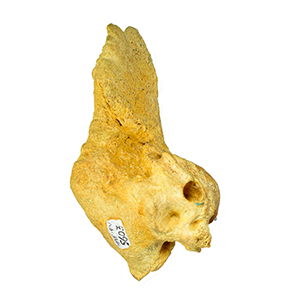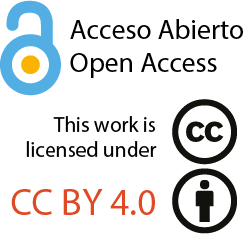CETOTHERIIDAE RECORDS FROM THE LATE MIOCENE OF PATAGONIA EXPAND THE DIVERSITY OF BALEEN WHALES FROM THE SOUTHWESTERN ATLANTIC OCEAN
Registros de Cetotheriidae del Mioceno Tardío en Patagonia amplían la diversidad de ballenas barbadas del Océano Atlántico sudoccidental
DOI:
https://doi.org/10.5710/PEAPA.22.10.2024.515Keywords:
Miocene, Puerto Madryn, Mysticetes, Evolution, NeogeneAbstract
The marine outcrops of the Patagonian Miocene (Argentina) encompass one of the most important assemblages of fossil mysticetes recorded worldwide, including key records of extant lineages. The Patagonian Late Miocene records comprise balaenids (right whales) or cetotheriids neobalaenines (pygmy right whales). In the last years, the increase of fieldwork efforts in Miocene outcrops of Patagonia has led to the discovery of new specimens, thus expanding our knowledge of mysticetes diversity from regional and global perspectives. In this work, we describe isolated ear bones collected from the Late Miocene Puerto Madryn Formation 12–2.7 Ma (Serravalian to Piacenzian), Península Valdés (Chubut Province), preliminarily attributed to Cetotheriidae. Although the lack of diagnostic elements precludes a more precise identification (at genus or specific level) within this family, our studies reveal a previously unknown diversity of morphotypes, indicating significant taxonomic diversity among these Patagonian mysticetes. In addition, the South Atlantic cetotheriid assemblage appears to be represented exclusively by large taxa, probably of pelagic habits, which may have facilitated their dispersal into the southern basins. Finally, these records suggest a rapid dispersion of cetotheriids from the Paratethys into the Southern Hemisphere during the Late Miocene, with the Southwest Atlantic Ocean representing their southernmost limit of distribution.
References
Adli, J. J., Deméré, T. A., & Boessenecker, R. W. (2014). Herpetocetus morrowi (Cetacea: Mysticeti), a new species of diminutive baleen whale from the Upper Pliocene (Piacenzian) of California, USA, with observations on the evolution and relationships of the Cetotheriidae. Zoological Journal of the Linnean Society, 170(2), 400–466. https://doi.org/10.1111/zoj.12108
Berta, A. & Lanzetti, A. (2020). Feeding in marine mammals: an integration of evolution and ecology through time. Palaeontologia Electronica, 23(2), a40. https://doi.org/10.26879/951
Bisconti, M. (2012). Comparative osteology and phylogenetic relationships of Miocaperea pulchra, the first fossil pygmy right whale genus and species (Cetacea, Mysticeti, Neobalaenidae). Zoological Journal of the Linnean Society, 166(4), 876–911. https://doi.org/10.1111/j.1096-3642.2012.00862.x
Bisconti, M. (2015). Anatomy of a new cetotheriid genus and species from the Miocene of Herentals Belgium and the phylogenetic and palaeobiogeographical relationships of Cetotheriidae (Mammalia, Cetacea, Mysticeti). Journal of Systematic Palaeontology, 13(5), 377–395. https://doi.org/10.1080/14772019.2014.890136
Bisconti, M., Pellegrino, L., & Carnevale, G. (2023). The chronology of mysticete diversification (Mammalia, Cetacea, Mysticeti): Body size, morphological evolution and global change. EarthScience Reviews, 239, 104373. https://doi.org/10.1016/j.earscirev.2023.104373
Boessenecker, R. W. (2011). Herpetocetine (Cetacea: Mysticeti) dentaries from the Upper Miocene Santa Margarita Sandstone of Central California. PaleoBios, 30(1), 1–12.
Boessenecker, R. W. (2013). Pleistocene survival of an archaic dwarf baleen whale (Mysticeti: Cetotheriidae). Naturwissenschaften, 100(4), 365–371. https://doi.org/10.5070/P9301021792
Bouetel, V. & de Muizon, C. (2006). The anatomy and relationships of Piscobalaena nana (Cetacea Mysticeti) a Cetotheriidae from the early Pliocene of Perú. Geodiversitas, 28(2), 319–395.
Brisson, M. J. (1762). Regnum animale in classes IX distributum, sive synopsis methodica: Sive Synopsis Methodica Sistens generalem Animalium distributionem in Classes IX, & duarum primarum Classium, Quadrupedum scilicet & Cetaceorum, particularem divisionem in Ordines, Sectiones, Genera & Species, Lugdum Batarorum, apud. Theodorum Haak, Leiden, 384.
Buono, M. R. (2014). Evolución de los Balaenidae (Mammalia, Cetacea, Mysticeti) del Mioceno de Patagonia: sistemática, filogenia y aspectos paleobiológicos. [PhD Thesis, Universidad Nacional de La Plata]. Retrieved from: https://doi.org/10.35537/10915/34939
Buono, M. R. & Cozzuol, M. A. (2013). A new beaked whale (Cetacea, Odontoceti) from the Late Miocene of Patagonia Argentina. Journal of Vertebrate Paleontology, 33(4), 986–997. https://doi.org/10.1080/02724634.2013.752377
Buono, M. R., Dozo, M. T., Marx, F. G., & Fordyce, R. E. (2014). A Late Miocene potential neobalaenine mandible from Argentina sheds light on the origins of the living pygmy right whale. Acta Palaeontologica Polonica, 59(4), 787–793. https://doi.org/10.4202/app.2012.0122
Buono, M. R., Viglino, M., Cozzuol, M. A., & Lucero, S. (2016). Descifrando la historia evolutiva de los Neoceti (Mammalia: Cetacea): aportes del registro fósil del Neógeno del Atlántico Sudoccidental. XXX Jornadas Argentinas de Paleontología de Vertebrados. (pp. 323-329). Buenos Aires.
Buono, M. R., Fernández, M. S., Cozzuol, M. A., Cuitiño, J. I., & Fitzgerald, E. M. (2017). The early Miocene balaenid Morenocetus parvus from Patagonia (Argentina) and the evolution of right whales. PeerJ, 5(1), e4148.
Buono, M. R., Gutstein, C. S., Gaetán, M., Paolucci, F., Viglino, M. (2022). Contribuyendo a la diversidad de los Inioidea (Cetacea: Odontoceti) en el Atlántico Sudoccidental: nuevos aportes del Mioceno Tardío de Patagonia. Publicación Electrónica de la Asociación Paleontológica Argentina, 23(R1), R36.
Cabrera, Á. (1926). Cetáceos fósiles del Museo de la Plata. Revista del Museo de la Plata, 29(1), 363–411.
Collareta, A., Landini, W., Lambert, O., Post, K., Tinelli, C., Di Celma, C., & Marchi, D. (2015). Piscivory in a Miocene Cetotheriidae of Perú: first record of fossilized stomach content for an extinct baleen-bearing whale. The Science of Nature, 102(70), 11–12. https://doi.org/10.1007/s00114-015-1319-y
Collareta, A., Marx, F. G., Casati, S., Di Cencio, A., Merella, M., & Bianucci, G. (2021). A cetotheriid whale from the upper Miocene of the Mediterranean. Neues Jahrbuch für Geologie und Paläontologie-Abhandlungen, 301(1), 9–16. https://dx.doi.org/10.1127/njgpa/2021/0994
Cope, E. D. (1895). Fourth contribution to the marine fauna of the Miocene period of the United States. Proceedings of the American Philosophical Society, 34(147), 135–155.
Cozzuol, M. A. (2001). A “northern” seal from the Miocene of Argentina: implications for phocid phylogeny and biogeography. Journal of Vertebrate Paleontology, 21(3), 415–421. https://doi.org/10.1671/0272-4634(2001)021[0415:ANSFTM]2.0.CO;2
Cuitiño, J. I., Dozo, M. T., Claudia, J., Buono, M. R., Palazzesi, L., Fuentes, S., & Scasso, R. A. (2017). Miocene marine transgressions: Paleoenvironments and paleobiodiversity. In P. Bouza & A. Bilmes (Eds.), Late Cenozoic of Península Valdés, Patagonia, Argentina: An Interdisciplinary Approach (pp. 47–84). Springer Earth System Sciences. https://doi.org/10.1007/978-3-319-48508-9_3
Cuitiño, J. I., Buono, M. R., Viglino, M., Farroni, N. D., & Bessone, S. (2019). Factors affecting the preservation and distribution of cetaceans in the lower Miocene Gaiman Formation of Patagonia, Argentina. Palaeogeography, Palaeoclimatology, Palaeoecology, 526(1), 110–125. https://doi.org/10.1016/j.palaeo.2019.03.013
Cuitiño, J. I., Bilmes, A., Buono, M. R, Bordese, S., Herazo, L., & Scasso, R. A. (2023). Stratigraphy, provenance, and timing of Neogene sedimentation in the western Valdés Basin, Patagonia. Accurate paleogeographic reconstructions as a key piece for Andean-passive margin integration. Journal of South American Earth Sciences, 124(1), 1–20. https://doi.org/10.1016/j.jsames.2023.104278
Dutoit, L., Mitchell, K. J., Dussex, N., Kemper, C. M., Larsson, P., Dalén, L., Rawlence, N. J., & Marx, F. G. (2023). Convergent evolution of skim feeding in baleen whales. Marine Mammal Science, 39, 1337–1343. https://doi.org/10.1101/2022.08.16.504064
Figueiredo, R., Bosselaers, M., Póvoas, L., & Castanhinha, R. (2024). Redescription of three fossil baleen whale skulls from the Miocene of Portugal reveals new cetotheriid phylogenetic insights. PLOS One, 19(3), e0298658. https://doi.org/10.1371/journal.pone.0298658
Fitzgerald, E. M. (2012). Possible neobalaenid from the Miocene of Australia implies a long evolutionary history for the pygmy right whale Caperea marginata (Cetacea, Mysticeti). Journal of Vertebrate Paleontology, 32(4), 976–980. https://doi.org/10.1080/02724634.2012.669803
Fordyce, R. E. & Marx, F. G. (2013). The pygmy right whale Caperea marginata: the last of the cetotheres. Proceedings of the Royal Society B: Biological Sciences, 280(1753), 20122645. https://doi.org/10.1098/rspb.2012.2645
Fordyce, R. E. & de Muizon, C. (2001). Evolutionary history of cetaceans: a reviews. Mazin, J. M. & Buffrénil, V. (Eds.) Secondary adaptation of tetrapods to life in water (pp. 169–233).
Verlag Dr. Friedrich Pfeil. Geisler, J. H., McGowen, M. R., Yang, G., & Gatesy, J. (2011). A supermatrix analysis of genomic, morphological, and paleontological data from crown Cetacea. BMC Evolutionary Biology, 11, 1–33. https://doi.org/10.1186/1471-2148-11-112
Gray, J. E. (1846). On the cetaceous animals. Richardson, J. & Gray, J.E. (Eds.), The Zoology of the voyage of HMS Erebus & Terror, Under the Command of Captain Sir James Clark Ross During the Years 1839 to 1843 (pp.13–53). EW Janson.
Gol’din, P. & Steeman, M. E. (2015). From problem taxa to problem solver: a new Miocene family, Tranatocetidae, brings perspective on baleen whale evolution. PLOS One, 10(9), e0135500. https://doi.org/10.1371/journal.pone.0135500
Gol’din, P. & Startsev, D. (2017). A systematic review of cetothere baleen whales (Cetacea, Cetotheriidae) from the Late Miocene of Crimea and Caucasus, with a new genus. Papers in Palaeontology, 3(1), 49–68. https://doi.org/10.1002/spp2.1066
Gol’din, P., Startsev, D., & Krakhmalnaya, T. (2014). The anatomy of the Late Miocene baleen whale Cetotherium riabinini from Ukraine. Acta Palaeontologica Polonica, 59(4), 795–814. https://doi.org/10.4202/app.2012.0107
Gol’din, P. (2018). New Paratethyan dwarf baleen whales mark the origin of cetotheres. PeerJ, 6, e5800. https://doi.org/10.7717/peerj.5800
Govender, R. & Marx, F. G. (2023). New cetacean fossils from the late Cenozoic of South Africa. Frontiers in Earth Science, 10, 1058104. https://doi.org/10.3389/feart.2022.1058104
Gutstein, C. S., Horwitz, F. E., Valenzuela-Toro, A. M., & FigueroaBravo, C. P. (2015). Cetáceos fósiles de Chile: context evolutivo y paleobiogeográfico. Publicación Ocasional del Museo Nacional de Historia Natural, Chile, 63, 339–387.
Haller, M. (1978). Estratigrafía de la región al poniente de Puerto Madryn, Provincia del Chubut, República Argentina. 6to Congreso Geológico Argentino, Actas del VII Congreso Geológico Argentino en Neuquén (pp. 285–297). Neuquén.
Lydekker, R. (1894). The La Plata Museum. Natural Science 4, 1–21.
Malumián, N. & Náñez, C. (2011). The Late Cretaceous–Cenozoic transgressions in Patagonia and the Fuegian Andes: foraminifera, palaeoecology, and palaeogeography. Biological Journal of the Linnean Society, 103(2), 269–288. https://doi.org/10.1111/j.1095-8312.2011.01649.x
Marx, F. G. & Fordyce, R. E. (2015). Baleen boom and bust: a synthesis of mysticete phylogeny, diversity, and disparity. Royal Society Open Science, 2(4), 140–434. https://doi.org/10.1098/rsos.140434
Marx, F. G. & Fordyce, R. E. (2016). A link no longer missing: New evidence for the cetotheriid affinities of Caperea. PLOS One, 11(10), e0164059. https://doi.org/10.1371/journal.pone.0164059
Marx, F. G., Bosselaers, M. E., & Louwye, S. (2016). A new species of Metopocetus (Cetacea, Mysticeti, Cetotheriidae) from the Late Miocene of the Netherlands. PeerJ, 4, e1572. https://doi.org/10.7717/peerj.1572
Marx, F. G., Lambert, O., & de Muizon, C. (2017). A new Miocene baleen whale from Perú deciphers the dawn of cetotheriids. Royal Society Open Science, 4(9), 170560. https://doi.org/10.1098/rsos.170560
Marx, F. G., Park, T., Fitzgerald, E. M., & Evans, A. R. (2018). A Miocene pygmy right whale fossil from Australia. PeerJ, 6, e5025. https://doi.org/10.7717/peerj.5025
Marx, F. G., Post, K., Bosselaers, M., & Munsterman, D. K. (2019). A large Late Miocene cetotheriid (Cetacea, Mysticeti) from the Netherlands clarifies the status of Tranatocetidae. PeerJ, 7, e6426. https://doi.org/10.7717/peerj.6426
Mead, J. G. & Fordyce, R. E. (2009). The therian skull: a lexicon with emphasis on the odontocetes. Smithsonian contributions to zoology, 627(1), 1–249. https://doi.org/10.5479/si.00810282.627
Mitchell, E. D. (1989). A new cetacean from the late Eocene La Meseta formation Seymour Island, Antarctic peninsula. Canadian Journal of Fisheries and Aquatic Sciences, 46(12), 2219–2235.
Scasso, R. & del Río, C. (1987). Ambiente de sedimentación, estratigrafía y proveniencia de la secuencia marina del Terciario Superior de la región de Península Valdés, Chubut. Revista de la Asociación Geológica Argentina, 42(4–3), 291–321.
Steeman, M. E. (2007). Cladistic analysis and a revised classification of fossil and recent mysticetes. Zoological Journal of the Linnean Society, 150(4), 875–894. https://doi.org/10.1111/j.1096-3642.2007.00313.x
Steeman, M. E., Hebsgaard, M. B., Fordyce, R. E., Ho, S. Y., Rabosky, D. L., Nielsen, R., & Willerslev, E. (2009). Radiation of extant cetaceans driven by restructuring of the oceans. Systematic biology, 58(6), 573–585. https://doi.org/10.1093/sysbio/syp060
Tanaka, Y., Ohara, M., & Kimura, T. (2023). A new specimen of cf. Isanacetus laticephalus (baleen whale) from the Oi Formation, Ichishi Group (late early Miocene) in Japan. Paleontological Research, 28(1), 26–36. https://doi.org/10.2517/PR210015
Tarasenko, K. K., Lopatin, A. V., & Startsev, D. B. (2020). The first finding of the Late Miocene baleen whales of the genus Zygiocetus (Cetotheriidae, Mysticeti) in Crimea (Melek-Chesme Locality, Kerch Peninsula). Doklady Biological Sciences, 491(1), 63–66. https://doi.org/10.1134/S0012496620020118
Torcărescu, B. A. (2023). Cetotheriidae (Cetacea, Mysticeti) from the Collections of the National Geological Museum, Bucharest (Romania). Zoodiversity, 57(3), 267–276.
Uhen, M. D. & Pyenson, N. D. (2007). Diversity estimates, biases, and historiographic effects: resolving cetacean diversity in the Tertiary. Palaeontologia Electronica, 10(2), 1–22.
Viglino, M., Buono, M. R., Acosta Hospitaleche, C., Cione, A., Cuitiño, J. I., Gaetán, C. M., Sterli, J., & Paolucci, F. (2021). Vertebrados marinos del Cenozoico de Chubut. Geología y recursos naturales de la provincia de Chubut. XXI Congreso Geológico Argentino (pp. 1005–1028). Puerto Madryn.
Viglino, M., Valenzuela-Toro, A. M., Benites-Palomino, A., Hernández-Cisneros, A. E., Gutstein, C. S., Aguirre-Fernández, G., Velez-Juarbe, J., Cozzuol, M. A; Buono, M. R., & Loch, C. (2023). Aquatic mammal fossils in Latin America–a review of records, advances and challenges in research in the last 30 years. The Latin American Journal of Aquatic Mammals, 18(1), 50–66. https://doi.org/10.5167/uzh-230742

Additional Files
Published
Issue
Section
License
Copyright (c) 2025 Azucena Solis-Añorve, Mónica R. Buono

This work is licensed under a Creative Commons Attribution-NoDerivatives 4.0 International License.
Authors retain copyright and grant the journal right of first publication with the work simultaneously licensed under a Atribución/Reconocimiento 4.0 Internacional that allows others to share the work with an acknowledgement of the work's authorship and initial publication in this journal.















